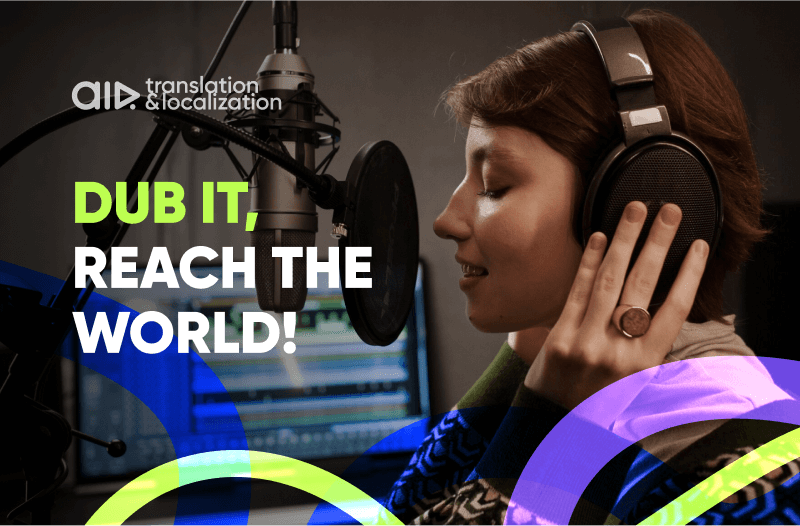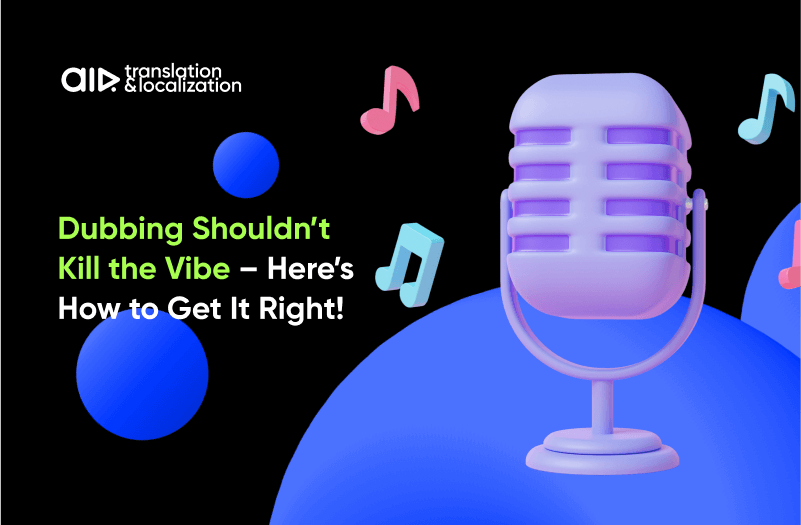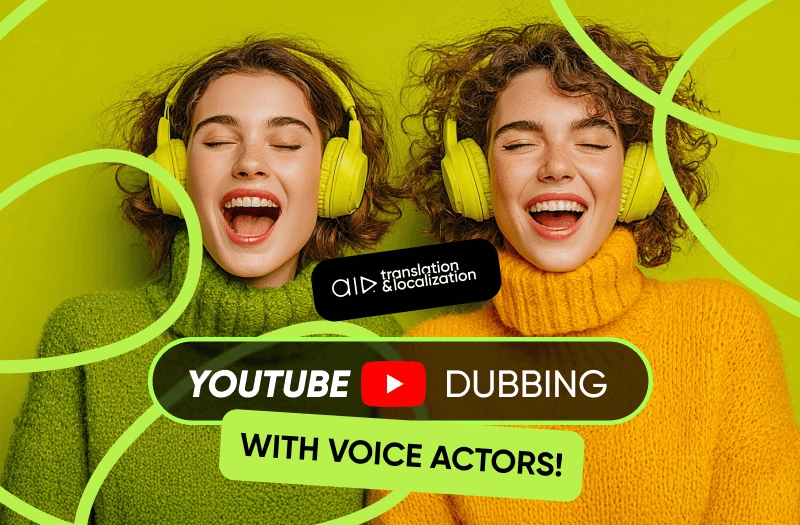
Not Sure Which Languages to Choose?
At first, it was just voiceovers and dubbed channels. Then YouTube dropped multi-track audio, and it was a huge deal. With its bugs at the beginning, sure, but still.
In this article, we break down dubbing vs. multi-language tracks. What’s better? What should you choose?
Spoiler: You can benefit from both.
How exactly? We analyzed over 400 of our localized channels and spotted a pattern. A lifehack, if you will.
The Surprising Case From AIR Translation Lab
One of the most unexpected growth hacks we discovered came straight from our AIR Translation Lab team.
For a range of creators they launched from 3 to 56 localized channels. In almost each case, there were 1-2 channels that had stalled. It had quality dubs, solid content, but YouTube wasn’t recommending it. No traction, no growth.
So, they tried something different.
Instead of keeping the translated content isolated, they uploaded multilingual audio tracks to both the localized and the main channels. That meant each channel carried not just its native audio, but all available dubs, including the original track.
The result?
Within weeks, the algorithm started picking up the localized channel. Recommendations kicked in. Watch time improved. Engagement followed. Moreover, the main channel’s traffic started growing too.
We’ve repeated this strategy across dozens of channels. It works. Audio tracks amplify your reach. Even channels that looked “dead” started showing signs of life again.
Want translated voiceovers for YouTube?
We’re an official YouTube-recommended vendor, and we don’t just hand over studio-level dubs. We plug in all the growth tactics we’ve learned from launching 400+ localized channels, so your translations actually perform. Contact us and we'll show what can be done.
When to Choose Separate Voiceover Channels
This option has several solid benefits. Let’s go through them:
#1. It’s An Independent Income Stream
A localized channel is a separate business.
It earns its own AdSense revenue, hits different CPMs, and stays alive even if your main channel takes a hit. You’re reaching new audiences and building financial safety nets at the same time. Some creators now make more from their dubbed channels than from their originals. That’s the power of YouTube voiceover in 2025.
#2. Community Building in New Markets
Localized channels build local fanbases and that means engagement. With tools like the Post Tab and auto-responders (like Oxys), you can drive polls, spark comments, and send engagement signals in every market, without speaking the language. It’s engagement at scale. And when YouTube sees that? It boosts you fast.
#3. More Brand Deals Than You Think
Take our partner Amelka Karamelka in Bulgarian and Serbian. Our team translated her channels with professional voice actors. The results:
- In Bulgaria: 12th in General Interest category in the country, with nearly 169M lifetime views.
- In Serbia: 6th across all categories, with 55M+ views.
Such localized channels opened up entirely new brand opportunities, and those deals don’t cannibalize your main channel. They layer on top. You’re replicating your success in new languages, with new revenue.
And we get it, building a new channel in a new market isn’t easy. You need to choose the right languages, find voice actors, analyze all the CPMs and PRMs, coordinate the process, moderate comments, and so on. It's no joke. But we’ve got the process down: dubbing, metadata, optimization, growth strategy, channel launching; we do it all. And you just earn on new markets.
Once you have those localized channels, you can layer on audio tracks across the board to lift every channel, even your main one.
What About Multi-Track Audio on YouTube?
It’s simple. It’s scalable. You add translated audio directly to your existing videos. Less overhead, faster rollout. Just make sure it’s not low-effort AI dubs unless you're testing.
Why? Because we’ve seen it firsthand:
AI dubbing leads to 4–5x lower average view duration.
And that’s a problem, because average view duration is the key metric YouTube uses to recommend content. Bad audio = bad watch time = less reach for every language track, including your original.
It can actively drag your performance down.
That’s why we tell creators: use multi-track, but do it right. For tests? Fine, try AI. But for scale, go with pro dubbing. Your retention depends on it.
We broke down our 3 AI vs pro dubbing cases that show the gap.

Still not sure?
Reach out to us. We've got YouTube audio tracks explained – clearly, simply.
Dubbing vs Multi-Track: Localized Audio on YouTube
So, a separate dubbed channel or multi-track audio?
If your goal is speed, go multi-track. It’s the quickest way to test international reach without touching your upload flow. No second channel. No split attention. You layer in translated audio, and that’s it. Ideal for long-form, education, commentary, or anything that holds up without cultural rewrites.
But if you want to own a market, dubbed channels win. More monetization routes, local brand deals, and a real shot at building regional loyalty. You are creating a fully immersive experience for your Spanish audience. That matters for lifestyle, entertainment, kids’ content, and anything built on tone, culture, or personality.
Here’s what we recommend creators:
- Start with multi-track to scout interest
- Launch dubbed channels once a market shows traction
- Test 10+ languages on your TOP 5 videos, then spot the winners. Here’s how one creator pulled 125M views using that exact strategy.
But if your audio track shows low engagement metrics, it can pull down your whole channel.
5 Tips on How to Improve Dubbing Quality
Let’s not make the YouTube algorithm mad. Here is how to improve your dubbing and prevent the flop:
- Localize the script, don’t just translate. Literal translations kill tone and pacing. Rewrite for flow, slang, and emotion in the target language — always with a native speaker.
- Use hybrid dubbing. We call it the 70/30 rule. Use real voice actors for intros, jokes, or emotional moments, and polish it with AI. It keeps costs down and engagement high.
- Train AI on real voices. Record 1–2 hours with a native speaker (or yourself). Feed that into your AI model. You’ll get dubs that sound natural, not synthetic.
- Always human-check the final audio. Even good AI needs polish. Native editors should tweak tempo, pitch, and emotion before it goes live. Don’t skip this.
- Go full human when it matters. For content heavy on delivery (vlogs, lifestyle, commentary), only a human dub will hold the vibe. Use AI where it fits, but don’t force it.
We’ve tested this across 400+ channels. If you're serious about dubbing, this is how you get it right. Want help building your stack? We’ve got the team.
Your Next Step
Translated channel + audio tracks = reach × retention × revenue.
We’ve helped dozens of creators add multiple languages to video. Channels that were flatlined found new life. Algorithms started recommending again. Brand deals started flowing. Monetization multiplied.
Want to localize with intent? We’ll help you build the stack, manage the dubs, and grow globally.





